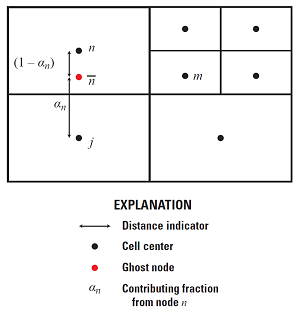GMS:GNC Package: Difference between revisions
From XMS Wiki
Jump to navigationJump to search
(Created page with "{{Version GMS 10.1}} {{MODFLOW Links}} {{Navbox GMS}} Category:MODFLOW") |
No edit summary |
||
| Line 1: | Line 1: | ||
{{Version GMS 10.1}} | {{Version GMS 10.1}} | ||
{{MODFLOW Links}} | {{MODFLOW Links}} | ||
The Ghost Node Correction (GNC) package is an optional package included in [[GMS:MODFLOW-USG|MODFLOW-USG]]. It can be used to correct errors in the model that are created “when a line between two connected nodes does not bisect the shared face at a right angle”.<ref name="mfusg"> | |||
{{citation | |||
|author=Panday, Sorab, Langevin, C.D., Niswonger, R.G., Ibaraki, Motomu, and Hughes, J.D., | |||
|title=MODFLOW-USG, version 1: An unstructured grid version of MODFLOW for simulating groundwater flow and tightly coupled processes using a control volume finite-difference formulation: U.S. Geological Survey Techniques and Methods, book 6, chap. A45, 66 p. | |||
|place=Reston, Virginia | |||
|year=2013 | |||
|url=http://water.usgs.gov/ogw/mfusg/ | |||
}}</ref> | |||
GMS provides an interface to the GNC package. The package can be turned on in the [[GMS:MODFLOW_Packages_Supported_in_GMS|MODFLOW Packages]] dialog, accessible from the [[GMS:Global_Options/Basic_Package|MODFLOW Global/Basic Package]] dialog. The package dialog can be accessed from the main [[GMS:MODFLOW_Commands|MODFLOW menu]] or by right-clicking on the MODFLOW item in the [[GMS:Project Explorer|Project Explorer]]. | |||
[[Image:ghostnodes.png|frame|none|Ghost node conceptualization for nested grids.<ref name="mfusg"/>]] | |||
The user can enter the ghost node data by hand, or allow GMS to compute the data by clicking the ''Generate Ghost Node Data'' button. Clicking the button causes GMS to overwrite whatever is in the GncNodes table with the ghost node data calculated using an algorithm based on ghost node locations and distances to adjacent cells. | |||
If the ''Create points at ghost node locations when generating'' option is on, GMS will create a new [[GMS:UGrid_Module|UGrid]] called "Ghost Nodes" with points located where GMS calculated that ghost nodes should be. | |||
GMS does not currently support some GNC package options, including: | |||
*Parameters | |||
*IFALPHAn (always 0 in GMS) | |||
==Notes== | |||
<references/> | |||
{{Navbox GMS}} | {{Navbox GMS}} | ||
[[Category:MODFLOW]] | [[Category:MODFLOW]] | ||
